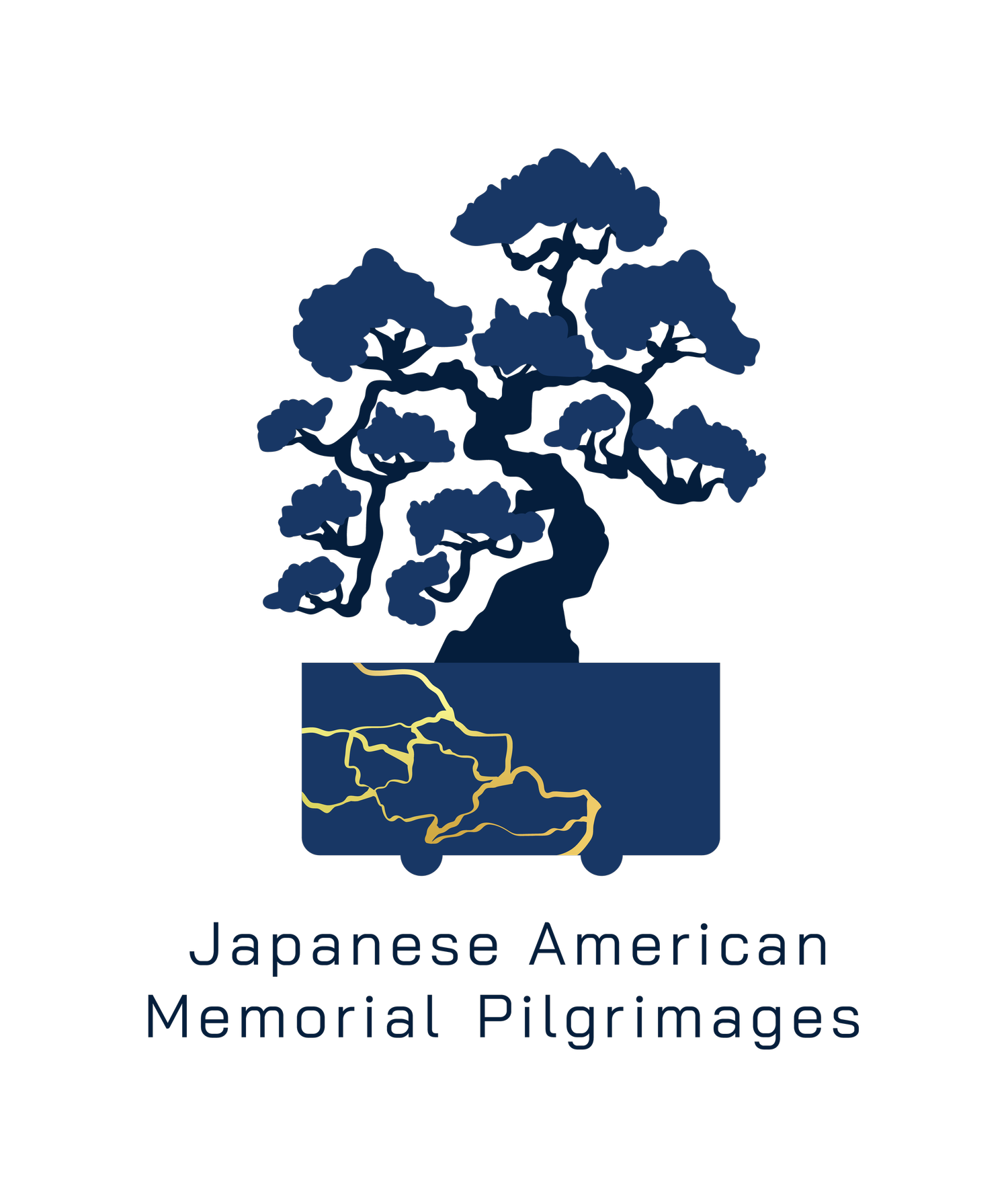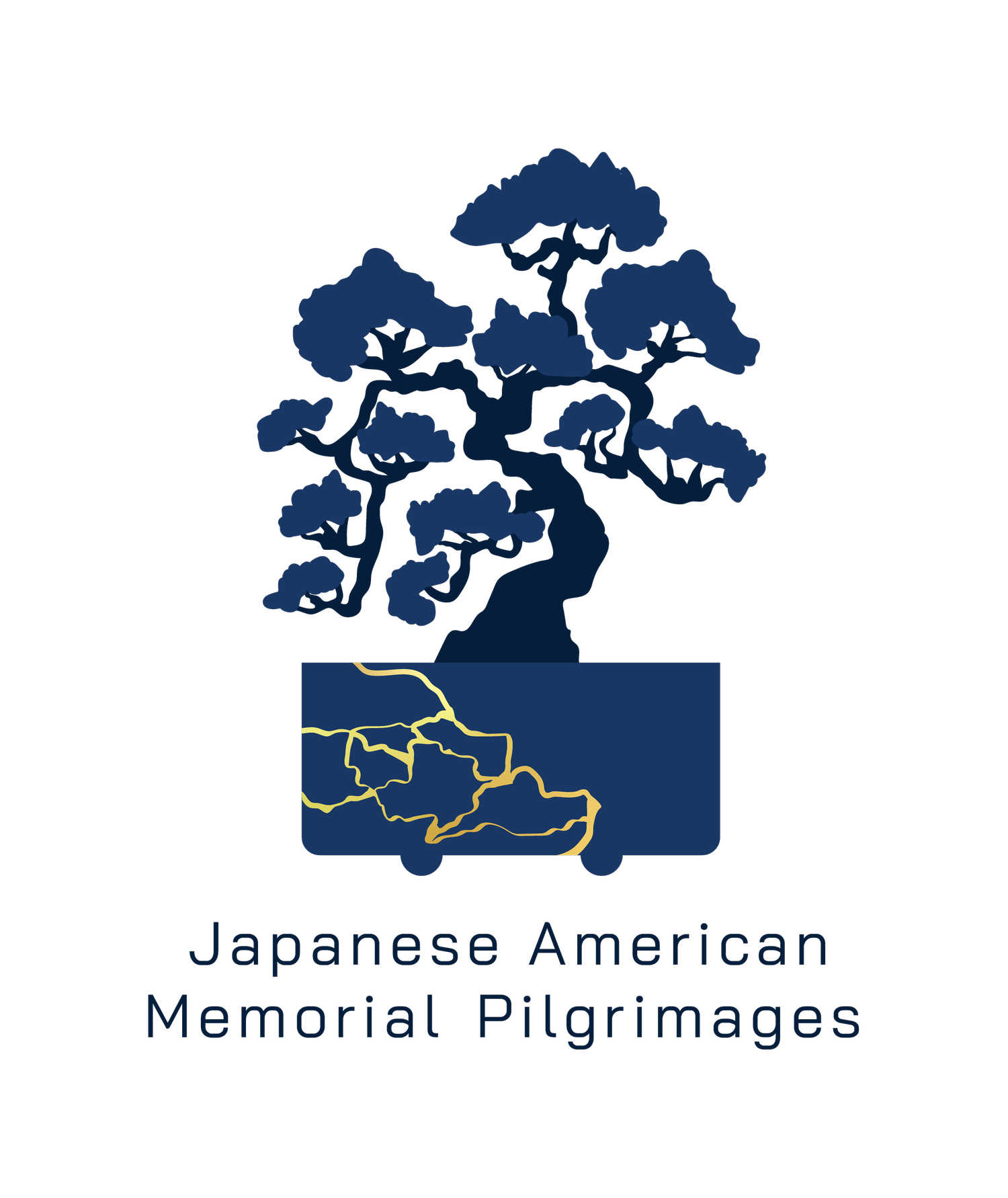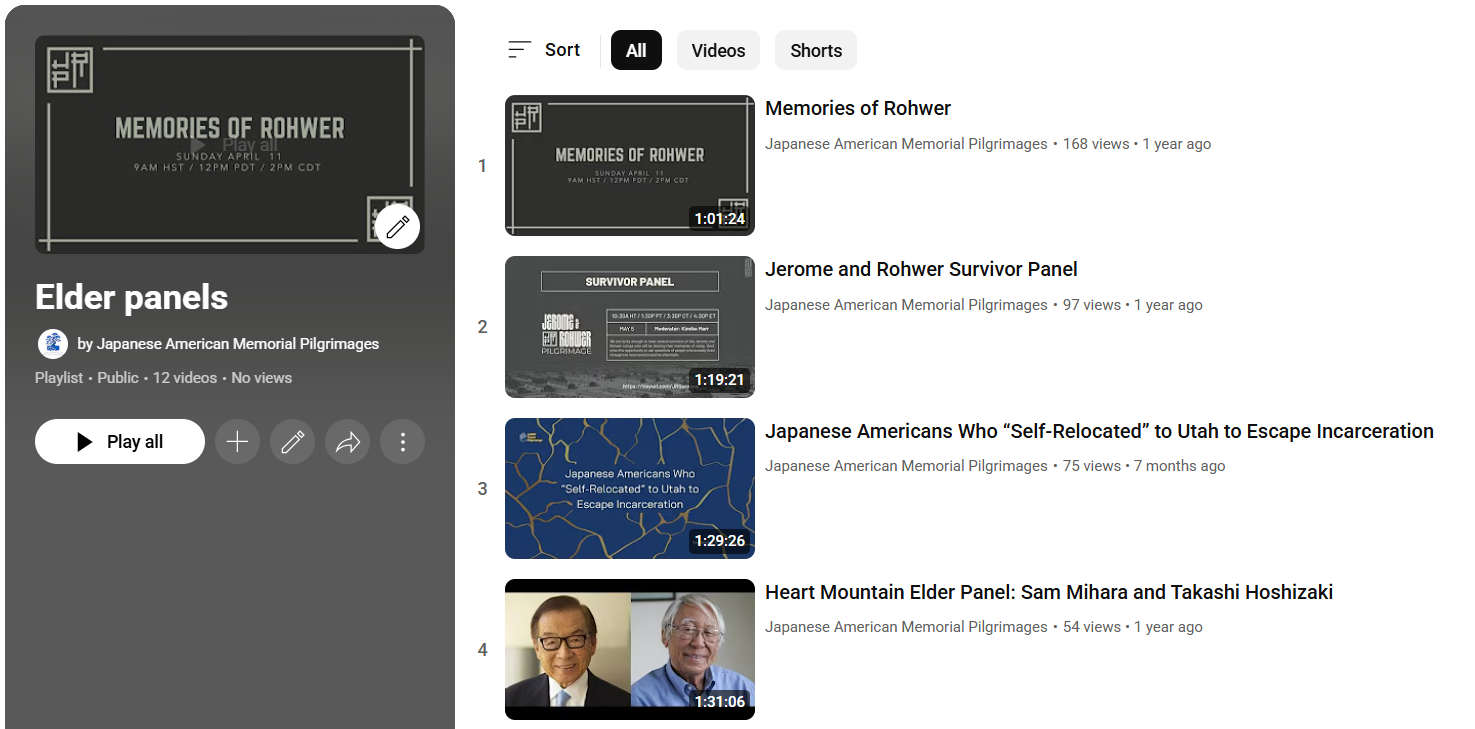
WEBSITES
-
Calisphere
Calisphere provides free access to unique and historically important artifacts for research, teaching, and curious exploration. Discover over two million photographs, documents, letters, artwork, diaries, oral histories, films, advertisements, musical recordings, and more.
-
Eastwind Books of Berkeley
If you would like another place to purchase books and support a small business, check out Eastwinds Books, a small but mighty bookstore that has served the Bay Area since 1982.
Note: Eastwind Books will have a booth selling books at the conference on Saturday, June 21!
-
Internet Archive
Digital Library of Japanese American Incarceration
A variety of literature about the WWII incarceration resides on the Internet Archive.
-
The Lim Report
A report commissioned by the JACL in 1989 to investigate the organization’s actions during WWII. When the report largely confirmed charges against the JACL by its detractors, it was largely suppressed by the organization. However, copies circulated widely through the community and it later became available on the Internet.
Courtesy of Frank Abe.
-
National Archives
Central Photographic File of the War Relocation Authority, 1942-1945
War Relocation Authority collection of photos from pre-WWII, WWII, and post-war.
-
Personal Justice Denied
Personal Justice Denied is the landmark 1983 report of the Commission on Wartime Relocation and Internment of Civilians (CWRIC), which investigated the U.S. government's forced relocation and incarceration of approximately 120,000 Japanese Americans during World War II. The report concluded that the mass imprisonment was not justified by military necessity but was instead driven by "race prejudice, war hysteria, and a failure of political leadership."
-
Reckoning
RECKONING is a multimedia experience about the Japanese American fight for redress and reparations in the 1980s — and the lessons it holds for communities seeking justice and healing today. The piece focuses specifically on the role of Chicago’s Japanese American community in the broader movement.
-
Sites of Shame - Densho
During World War II, more than 125,000 individuals of Japanese ancestry were held without trial in a complex network of detention sites throughout the U.S. Over two-thirds of those imprisoned were U.S. citizens.
Forty years later, the U.S. government determined that the incarceration was wrong and President Ronald Reagan signed the Civil Liberties Act of 1988. While many of the physical sites have faded into the landscape, their history serves as a reminder of the fragility of our democracy.
-
Uprooted
UPROOTED is an interactive multimedia experience about the multigenerational effects of Japanese American incarceration during World War II — from the West Coast to Chicago.
PARTICIPANT QUESTIONS
Listed below are some of the topics that those who have registered for the conference are interested in learning more about, along with videos from Tadaima! A Community Virtual Pilgrimage and partner organizations which address these topics.
ACTIVISM
JAMPilgrimages has multiple videos about ACTIVISM in the Japanese American Community. Click on this link to check out our YouTube playlist!
HAWAI`I
JAMPilgrimages has multiple videos about HAWAI`I. Click on this link to check out our YouTube playlist!
INTERGENERATIONAL TRAUMA
JAMPilgrimages has multiple videos about INTERGENERATIONAL TRAUMA. Click on this link to check out our YouTube playlist!
Return to Tule Lake
The Kittaka Family
The Kushino-Ogino Family
Teiko and Spencer
Child Prisoner: Kai & Minkie - A Nisei Perspective
Child Prisoner: Masao & Trevyr - Issei and Yonsei Perspectives
Child Prisoner: Lance, Laura, DeeAn, and Mark - Sansei Perspectives
ISSEI
The Issei Gerontology Project-Japanese American Service Committee
These four films were produced by JASC in 1975 as part of the Issei Gerontology Project, which focused on the needs of Chicago’s aging population of Issei, or first generation Japanese immigrants. The original 16mm films were preserved for decades in the JASC archives and digitized with grant funding and community support in 2019. They offer a rare opportunity to see and hear Issei speaking about their experiences, and also offer a glimpse into the programs and services of JASC in the mid-1970s.
The buried past of Issei writing in camp is uncovered in two new publication projects. Heart Mountain Wyoming Foundation Museum Manager Cally Steussy will unveil the foundation’s new translations of the Heart Mountain Bungei literary magazine, joined by two of the translators, Lisa Hofmann-Kuroda and Allison Markin Powell. Writer/editor Frank Abe will discuss other recent translations of Issei writing planned for the forthcoming Penguin Book of the Literature of Japanese American Incarceration, including two commissioned from the Tule Lake Tessaku magazine.
Unlocking Issei Voices in Camp Literature
In many first generation Japanese histories, the story of women has been limited to primarily two narratives: the reticent and subservient picture bride and the hard-working, silent plantation field laborer. Defined by their husbands and their secondary economic status, Issei women’s activities in Hawai‘i have not been regarded as worthy of close historical analysis. While many women arrived in the Islands as picture brides and most labored on the plantations, these simplistic characterizations do not capture the wide range of activities performed by Issei women. Dr. Kelli Nakamura will shed light on this “invisible” population.
Issei Women and Work in Hawai‘i
JAPANESE DIASPORA
JAMPilgrimages has multiple videos about the JAPANESE DIASPORA. Click on this link to check out our YouTube playlist!
JAPANESE LATIN AMERICAN EXPERIENCE DURING WWII
JAMPilgrimages has multiple videos about the JAPANESE LATIN AMERICAN EXPERIENCE. Click on this link to check out our YouTube playlist!
OKINAWAN EXPERIENCE
In Search of Incarcerated Okinawans: A Conversation on Decolonizing Japanese America
When discussing the wartime incarceration sites, we speak almost exclusively of Japanese Americans. This works to erase the fact that there were also a significant number of individuals of Okinawan descent who were incarcerated. While some Okinawans may prefer to identify as Japanese American, this must be understood in a context where Okinawans were navigating anti-Asian racism from the United States government as well as anti-Okinawan racism from the larger Japanese community. The camps, along with many other sites across time and space, have been places where Okinawans have had to fight double colonialism at the hands of both Japanese and American nationalisms.
This program will include poetry by Sho and a Sanshin performance by Joseph Kamiya.
Yuntaku as a Doorway to Healing and Creative Expression in the Okinawan Diaspora
In this session, we will draw on the practice of yuntaku, which means “talking story, chatting” and refers to an unstructured time of “hanging out” where relationships evolve organically and connections are formed. There is no agenda for yuntaku time; there is no product-oriented activity. Yuntaku allows for breathing room and building trust and camaraderie in an anti-capitalist framework.
We will take a brief dive into the elements surrounding this incredible unique land, people, and culture through the the lenses of authors Akemi Johnson, Night in the American Village, and Elizabeth Miki Brina, Speak, Okinawa, in a conversation moderated by Mariko Middleton of the Ichariba Choodee: Okinawan Voices and Stories Podcast. We’ll talk about identity, inspiration, history, and inquire into the future of Okinawa, concluding with hopes and dreams.
Authors in Conversation Akemi Johnson & Elizabeth Miki Brina
PRESERVATION & INTERPRETATION AT THE SITES
JAMPilgrimages has multiple videos about PRESERVATION and INTERPRETATION at the incarceration sites. Click on this link to check out our YouTube playlist!
REDRESS & REPARATIONS
JAMPilgrimages has multiple videos about REDRESS and REPARATIONS. Click on this link to check out our YouTube playlist!
JAMP also has videos about Japanese Latin American reparations and Japanese Canadian reparations. Check them out below.
The Continuing Fight for Justice for Japanese Latin Americans
Under the historic Civil Liberties Act of 1988, the U.S. government declared over 2200 men, women, and children of Japanese ancestry from 13 Latin American countries "ineligible" for redress because they were “illegal aliens.” And yet it was the U.S. government that orchestrated an international hostage exchange program and their imprisonment in US concentration camps. Almost 80 years after these war crimes were committed, the U.S. government still refuses acknowledgment and proper redress. Learn about this ongoing fight to hold the U.S. government accountable, its relevance today, and the significance of the latest development in this struggle for justice.
Legacy of Redress
For Japanese Canadians, the legacy of Redress is to work towards the elimination of racial discrimination and intolerance, and work with other Canadian groups and Indigenous peoples for justice and equity for all people. Both Indigenous and Japanese Canadian stories have been left out of the historical narrative of Canada for too long. Speakers will share their perspectives of their communities and the intersection of Indigenous peoples and Japanese Canadians in their fight for their rights, their communities, and their environment.
RESETTLEMENT
JAMPilgrimages has multiple videos about RESETTLEMENT. Click on this link to check out our YouTube playlist!
RESISTANCE
JAMPilgrimages has multiple videos about RESISTANCE. Click on this link to check out our YouTube playlist!
The United States vs. Takashi Hoshizaki
Takashi Hoshizaki was 18 years old and incarcerated in the Heart Mountain camp when he was notified that he needed to report for his physical and be inducted into the US military in 1944. Takashi decided that until he was given his civil rights back and released from the camp, he would not agree to be drafted.
The Descendants of a Heart Mountain Resister
The family of James Tsutomu Uyeda come together to discuss what shaped his life, his decision to resist the draft and subsequent imprisonment at McNeil Island, Washington State. James' daughter, grandchild, and great grandchildren talk about the lasting effects of his resistance.
Contrary to the perception that the Japanese Americans passively and silently submitted to the mass incarceration during WWII, we now know from historical research that in fact there was very active and continuous resistance in the camps by Japanese Americans to protest the racist injustice and the loss of their constitutional and civil rights.
Thousands of Japanese Americans organized protests inside the concentration camps throughout the period of incarceration. The prisoners held many work strikes, formed committees to meet with the War Relocation Authority (WRA) administrators to explain and press their demands, wrote statements/letters/petitions which they sent not only to the WRA but also to President Roosevelt, Eleanor Roosevelt, Dept. of War and other federal agencies. There were large meetings and outdoor protest gatherings of hundreds and thousands of people at a time.
These various forms of resistance involved Japanese Americans from all backgrounds and walks of life, and took place throughout the camps. Women, notably Issei women, were prominent and articulate voices in demanding the restoration of civil rights. Issei in some cases were able to provide significant leadership despite all of the attempts of the U.S. government to completely dis-empower them.
Not everyone in the camps participated in or supported these acts of resistance. Disagreements in the community over how to respond to racism and the government dated back to years before the incarceration. Another factor was that repression by the Army, FBI and WRA was swift and severe for those considered “troublemakers,” who were often arrested, separated from their family and sent to the Tule Lake stockade, a Citizen Isolation Center or federal penitentiary.
Much of the resistance was very principled and well-considered. But frustration and anger in the confined pressure-cooker situation which the government had put everyone in, unfortunately did lead to some tactics of intimidation by various factions and some violence. The government played a large role in exacerbating animosity and tensions between different sectors of Japanese Americans and within families, particularly with the “Loyalty Questionnaire” and imposing the draft. Thousands were unjustly labeled “disloyal,” ostracized and socially isolated long after WWII was over.
This “Timeline of Resistance” is not a complete or scholarly document, but is an initial attempt to gather at least some of the scattered information about resistance for the period of 1942-1946 into one list. Also attached are some “Statements of Resistance” – as written by Japanese Americans while in the camps. This Timeline only focuses on the more organized forms of resistance, and does not include the many acts of resistance by countless individuals which took place on a daily basis.
Yuri Miyagawa and Chizu Omori, 8/12/19
SURVIVOR STORIES
JAMPilgrimages has multiple videos with SURVIVORS. Click on this link to check out our YouTube playlist!
Mits
Robert Ito
Bainbridge Island: Lilly's Story
Rinko
“VOLUNTARY EVACUATION”
Japanese Americans Who “Self-Relocated” to Utah to Escape Incarceration
From Salt Lake City to Keetley to Brigham City and beyond, 1,519 Japanese Americans fled the West Coast and found refuge in Utah. Their experiences presented unique challenges, distinct from those faced by those incarcerated in Topaz.
The World War II involuntary incarceration of over 125,000+ people of Japanese descent in the United States is a well-documented part of American history, but have you heard the stories of those who “voluntarily” moved outside of the Exclusion Zone to escape forced incarceration? Yukari Vicky Mikesell and her daughter, Sandra Mikesell Buscher share their talk story conversation in which Yukari reveals her family's heartbreaking departure from their Los Angeles home in the Exclusion Zone to escape the mass incarceration and establish a new life in the unknowns of Utah. Join them for this fascinating history!
EO 9066 Voluntary Evacuees: Yukari's Story
This panel features three descendants of Issei parents who took their families out of the military's designated "evacuation" zones after EO 9066. These families relocated to a small mining community called Keetley, near Park City, Utah.
Mary Wada Roath is the daughter of Fred Wada, who spearheaded the major move out of California and helped identify families who could contribute to the new colony. Howard Yamamoto was a child in Keetley and recalls the struggles that his parents endured to make it to Utah. Emiko Katsumoto was born in Salt Lake City after her family, the Endo clan, left the Keetley farm. Due to the difficulties of farming at such high elevation and the small financial returns on their work, the Endo Clan left the Keetley farm after only two months.
A Place to Escape: Japanese Americans in Keetley During WWII
WRA RECORDS
World War II Japanese American Incarceration: Researching an Individual or Family (via National Archives)
Conducting genealogical research on formerly incarcerated Japanese and Japanese Americans can present a challenge for even the most adept researcher. Due to the involvement of multiple federal agencies in detaining and documenting individuals of Japanese descent (U.S. citizens, permanent residents, and those taken from U.S. territories and from Allied held nations), records may be found across several different record groups and at a number of National Archives and Records Administration (NARA) facilities across the country. The process of identifying individual or family records can be complicated due to the absence of any official master index and the fact that some of the formerly incarcerated were transferred between multiple camps.
This guide provides an overview of the types of records available for genealogical research and offers guidance on how to navigate them. You can continue your research with records at NARA by visiting us, contacting us online, or by hiring an independent researcher.
YOUTH PERSPECTIVES
Our Ancestors Wildest Dreams: A Live YSPN Recording
Join members of Nikkei Rising's Yon-Say Podcast Network (YSPN) in conversation with other young adult leaders in the Japanese American community about what they see as the future of the community. They will share struggles, hopes, and experiences and will also open up for audience Q&A at the end to have a more open dialogue between the generations.
Nikkei Spaces on College Campuses
Cultural organizations across college campuses provide a space for students to find community through cultural connection. These organizations serve many purposes; social groups, practice for cultural traditions, language resources, advocacy, professional development, etc. Whether a Nikkei Student Union, Japan Student Association, Asian American Student Union, cultural performance groups, etc., what roles do these organizations play on college campuses? How are they similar, how do they differ? Who joins a cultural organization? Join the community as we discuss Nikkei spaces on college campuses.











